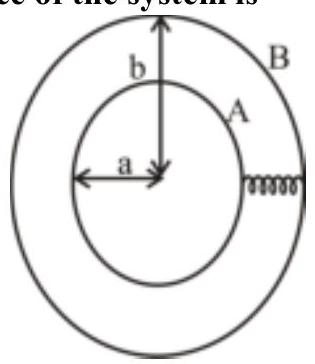165660 A pair of parallel metal plates are kept with a separation $d$. One plate is at a potential $+\mathrm{V}$ and the other is at ground potential. A narrow beam of electrons enters the space between the plates with a velocity $v_{0}$ and in a direction parallel to the plates. What will be the angle of the beam with the plates after it travels an axial distance $L$ ?
165661 A parallel plate capacitor in series with a resistance of $100 \Omega$, an inductor of $20 \mathrm{mH}$ and an AC voltage source of variable frequency shows resonance at a frequency of $\frac{1250}{\pi} \mathrm{Hz}$. If this capacitor is charged by a DC voltage source to a voltage $25 \mathrm{~V}$, what amount of charge will be stored in each plate of the capacitor?
165660 A pair of parallel metal plates are kept with a separation $d$. One plate is at a potential $+\mathrm{V}$ and the other is at ground potential. A narrow beam of electrons enters the space between the plates with a velocity $v_{0}$ and in a direction parallel to the plates. What will be the angle of the beam with the plates after it travels an axial distance $L$ ?
165661 A parallel plate capacitor in series with a resistance of $100 \Omega$, an inductor of $20 \mathrm{mH}$ and an AC voltage source of variable frequency shows resonance at a frequency of $\frac{1250}{\pi} \mathrm{Hz}$. If this capacitor is charged by a DC voltage source to a voltage $25 \mathrm{~V}$, what amount of charge will be stored in each plate of the capacitor?
165660 A pair of parallel metal plates are kept with a separation $d$. One plate is at a potential $+\mathrm{V}$ and the other is at ground potential. A narrow beam of electrons enters the space between the plates with a velocity $v_{0}$ and in a direction parallel to the plates. What will be the angle of the beam with the plates after it travels an axial distance $L$ ?
165661 A parallel plate capacitor in series with a resistance of $100 \Omega$, an inductor of $20 \mathrm{mH}$ and an AC voltage source of variable frequency shows resonance at a frequency of $\frac{1250}{\pi} \mathrm{Hz}$. If this capacitor is charged by a DC voltage source to a voltage $25 \mathrm{~V}$, what amount of charge will be stored in each plate of the capacitor?
165660 A pair of parallel metal plates are kept with a separation $d$. One plate is at a potential $+\mathrm{V}$ and the other is at ground potential. A narrow beam of electrons enters the space between the plates with a velocity $v_{0}$ and in a direction parallel to the plates. What will be the angle of the beam with the plates after it travels an axial distance $L$ ?
165661 A parallel plate capacitor in series with a resistance of $100 \Omega$, an inductor of $20 \mathrm{mH}$ and an AC voltage source of variable frequency shows resonance at a frequency of $\frac{1250}{\pi} \mathrm{Hz}$. If this capacitor is charged by a DC voltage source to a voltage $25 \mathrm{~V}$, what amount of charge will be stored in each plate of the capacitor?
165660 A pair of parallel metal plates are kept with a separation $d$. One plate is at a potential $+\mathrm{V}$ and the other is at ground potential. A narrow beam of electrons enters the space between the plates with a velocity $v_{0}$ and in a direction parallel to the plates. What will be the angle of the beam with the plates after it travels an axial distance $L$ ?
165661 A parallel plate capacitor in series with a resistance of $100 \Omega$, an inductor of $20 \mathrm{mH}$ and an AC voltage source of variable frequency shows resonance at a frequency of $\frac{1250}{\pi} \mathrm{Hz}$. If this capacitor is charged by a DC voltage source to a voltage $25 \mathrm{~V}$, what amount of charge will be stored in each plate of the capacitor?

